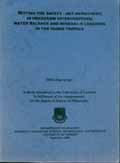| Thesis |
 |
|
| Title | Testing the safety-net hypothesis in hedgerow intercropping water balance and mineral-N leaching in the humid tropic | | Author | Didik Suprayogo | | Year | 2000 | | Academic Departement, University | University of London | | City | London, UK | | Number of Pages | 316 | | Departement | Biology | | Degree | PhD | | Call Number | TD0087-04 | | Keywords | Safety-net Hypothesis, Hedgerow, Intercropping, Water, Mineral, Humid tropic |
|
| Abstract: |
| Arable land in Indonesia is dominated by Ultisols, with shallow crop root development, relatively coarse texture, low cation exchange capacity and low organic matter content. These soil characteristics, along with 1500 to 3500 mm annual rainfall can result in significant N03 -N leaching. Hedgerow intercropping systems, with deep tree roots extending beneath the main crop rooting zone, can potentially intercept leached nutrients and recycle them, thereby acting as a safety net. The effects of crop rooting depth, tree root length density, N-availability, water content and water movement on safety-net efficiency in hedgerow intercropping systems were evaluated using both field and modelling techniques. Peltophorum dasyrrachis and Gliricida sepium trees were found to have very contrasting root patterns and length. Gliricida had an extensive rooting system, whereas peltophorum roots were less extensive in tile topsoil (0.2 m depth), but more deeply penetrating (up to 0.8 m depth). High levels of drainage (52% - 64% of total water losses),from this soil has resulted in most of the mineral-N (66 - 84 %) being in the subsoil (0.2 - 0.8 m depth) where it is almost inaccessible to crops. Field measurements showed that N-leaching was up to 73% (2.0 g N M-2) lower (Fp,.< 0.005) in the peltophorum hedgerow intercropping system than in tile maize - groundnut monocropping system (6.5 g N m-2 ). However, gliricidia and alternate peltophorum and gliricidia hedgerow intercropping systems had no significant effect of mineral -N -leaching. This suggested that tile safety net function was more efficient in the peltophorum hedgerow intercropping system than in the other cropping systems. The peltophorum trees also had beneficial effects on soil structure, soil organic matter and crop productivity. Model simulation indicated that there was the potential for N leaching to be reduced by up to 20 % by cation and anion exchange. Thus peltophorum hedgerow intercropping systems have the potential to reduce nutrient losses from tree-based farming systems on Indonesian Ultisols. In this project the model of Water, Nutrient and Light Capture in Agroforestry Systems (WaNuLCAS) was adopted and tested against measured field data. Although this model adequately simulated experimental and conceptual information required for understanding tree and crop interactions, it still needs to be further developed as it was found to either overestimate or underestimate outputs compared with field measured data. |
|